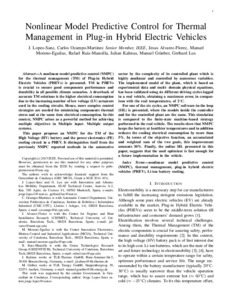Mostra el registre d'ítem simple
Nonlinear model predictive control for thermal management in plug-in hybrid electric vehicles
| dc.contributor.author | López Sanz, Jorge |
| dc.contributor.author | Ocampo-Martínez, Carlos |
| dc.contributor.author | Álvarez Flórez, Jesús Andrés |
| dc.contributor.author | Moreno Eguilaz, Juan Manuel |
| dc.contributor.author | Ruiz Mansilla, Rafael |
| dc.contributor.other | Universitat Politècnica de Catalunya. Departament de Màquines i Motors Tèrmics |
| dc.contributor.other | Universitat Politècnica de Catalunya. Departament d'Enginyeria de Sistemes, Automàtica i Informàtica Industrial |
| dc.contributor.other | Universitat Politècnica de Catalunya. Departament d'Enginyeria Electrònica |
| dc.date.accessioned | 2017-04-04T10:10:17Z |
| dc.date.available | 2017-04-04T10:10:17Z |
| dc.date.issued | 2017-05 |
| dc.identifier.citation | Lopez, J., Ocampo-Martinez, C.A., Alvarez, J.A., Moreno-Eguilaz, J.M., Ruiz Mansilla, R. Nonlinear model predictive control for thermal management in plug-in hybrid electric vehicles. "IEEE transactions on vehicular technology", 2 Agost 2016, núm. 99, p. 1-15. |
| dc.identifier.issn | 0018-9545 |
| dc.identifier.uri | http://hdl.handle.net/2117/103254 |
| dc.description | © 2016 IEEE. Personal use of this material is permitted. Permission from IEEE must be obtained for all other uses, in any current or future media, including reprinting/republishing this material for advertising or promotional purposes, creating new collective works, for resale or redistribution to servers or lists, or reuse of any copyrighted component of this work in other works. |
| dc.description.abstract | A nonlinear model predictive control (NMPC) for the thermal management (TM) of Plug-in Hybrid Electric Vehicles (PHEVs) is presented. TM in PHEVs is crucial to ensure good components performance and durability in all possible climate scenarios. A drawback of accurate TM solutions is the higher electrical consumption due to the increasing number of low voltage (LV) actuators used in the cooling circuits. Hence, more complex control strategies are needed for minimizing components thermal stress and at the same time electrical consumption. In this context, NMPC arises as a powerful method for achieving multiple objectives in Multiple input- Multiple output systems. This paper proposes an NMPC for the TM of the High Voltage (HV) battery and the power electronics (PE) cooling circuit in a PHEV. It distinguishes itself from the previously NMPC reported methods in the automotive sector by the complexity of its controlled plant which is highly nonlinear and controlled by numerous variables. The implemented model of the plant, which is based on experimental data and multi- domain physical equations, has been validated using six different driving cycles logged in a real vehicle, obtaining a maximum error, in comparison with the real temperatures, of 2C. For one of the six cycles, an NMPC software-in-the loop (SIL) is presented, where the models inside the controller and for the controlled plant are the same. This simulation is compared to the finite-state machine-based strategy performed in the real vehicle. The results show that NMPC keeps the battery at healthier temperatures and in addition reduces the cooling electrical consumption by more than 5%. In terms of the objective function, an accumulated and weighted sum of the two goals, this improvement amounts 30%. Finally, the online SIL presented in this paper, suggests that the used optimizer is fast enough for a future implementation in the vehicle. |
| dc.format.extent | 15 p. |
| dc.language.iso | eng |
| dc.rights | Attribution-NonCommercial-NoDerivs 3.0 Spain |
| dc.rights.uri | http://creativecommons.org/licenses/by-nc-nd/3.0/es/ |
| dc.subject | Àrees temàtiques de la UPC::Enginyeria mecànica::Disseny i construcció de vehicles::Automòbils |
| dc.subject | Àrees temàtiques de la UPC::Enginyeria elèctrica::Electromecànica |
| dc.subject.lcsh | Hybrid electric vehicles |
| dc.subject.lcsh | Electric batteries |
| dc.subject.other | Batteries |
| dc.subject.other | Vehicles |
| dc.subject.other | Valves |
| dc.subject.other | Cooling |
| dc.subject.other | Heat transfer |
| dc.subject.other | Thermal management |
| dc.subject.other | Mathematical model |
| dc.title | Nonlinear model predictive control for thermal management in plug-in hybrid electric vehicles |
| dc.type | Article |
| dc.subject.lemac | Vehicles elèctrics híbrids |
| dc.subject.lemac | Bateries elèctriques |
| dc.contributor.group | Universitat Politècnica de Catalunya. CREMIT - Centre de Recerca de Motors i Instal·lacions Tèrmiques |
| dc.contributor.group | Universitat Politècnica de Catalunya. SAC - Sistemes Avançats de Control |
| dc.contributor.group | Universitat Politècnica de Catalunya. MCIA - Motion Control and Industrial Applications Research Group |
| dc.contributor.group | Universitat Politècnica de Catalunya. GREENTECH - Grup de Recerca en Tecnologies Renovables |
| dc.identifier.doi | 10.1109/TVT.2016.2597242 |
| dc.relation.publisherversion | http://winet.ece.ufl.edu/tvt/ |
| dc.rights.access | Open Access |
| local.identifier.drac | 19828652 |
| dc.description.version | Accepted version |
| local.citation.author | Lopez, J.; Ocampo-Martinez, C.A.; Alvarez, J.A.; Moreno-Eguilaz, J.M.; Ruiz Mansilla, Rafael |
| local.citation.publicationName | IEEE transactions on vehicular technology |
| local.citation.number | 99 |
| local.citation.startingPage | 1 |
| local.citation.endingPage | 15 |
Fitxers d'aquest items
Aquest ítem apareix a les col·leccions següents
-
Articles de revista [21]
-
Articles de revista [1.390]
-
Articles de revista [48]
-
Articles de revista [507]
-
Articles de revista [471]
-
Articles de revista [232]
-
Articles de revista [1.721]


